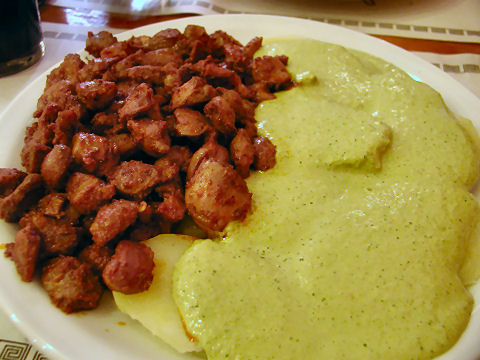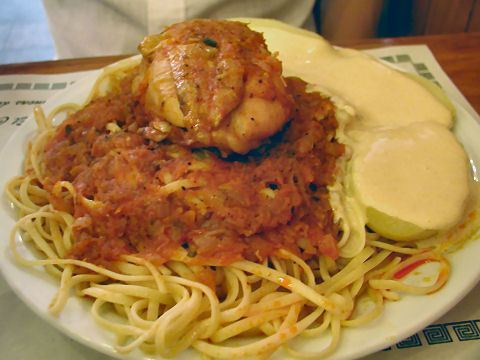“I come from long ago, from a magnificent and great empire, from a cast of sorcerers, holy men, and the masters of the sun.
– Mamani Mamani, Artist
Buenos Aires – It always sounded like a hole-in-the-wall, one of the ubiquitous Peruvian eateries that fill the neighborhood near to the Abasto. And so, given that there were places around that we really liked, and that looked like you might actually have a good meal in them, we hadn’t bothered with Mamani, Lavalle 3034, now at the corner of Lavalle and Agüero. So, we make mistakes. The name, both the Quechua and Aymara word for either a hawk or falcon, is also a fairly common altiplano surname. The place looks just like the sort of place that you’d hover at the door, trying to decide if you really wanted to enter and subject yourself to the service and food that is to come. [Closed permanently during the pandemic. Their smaller spot in San Telmo at Defensa 873 remains open.]
As I said, we make mistakes. The place is no real hole-in-the-wall, it easily seats a hundred and some folk, and apparently in the evening, does so with others waiting for tables. They’re famous amongst those “in the know” for their spit roasted chicken, which we didn’t try, not knowing that the day we wandered in – and several local amateur critics commented that nothing else was worth bothering with. So we’re not the only ones who make mistakes.


We also went for a pitcher of chicha morada, the purple corn soft drink – which I normally find too sweet in restaurants here, but this version, in an easily 1½ liter pitcher, was just semi-sweet and packed with fruit and spices, the way Henry taught me to make it.
Overall, great marks for truly traditional homestyle Peruvian cooking, low prices (lunch cost us a whole 44 pesos for all this), friendly and reasonably efficient service. Ambiance, más o menos as they say here, but when digging in to this kind of food, who cares?
[Note: read update comment below]
I agree that this place doesn’t look like much on the outside, but the food was plentiful and flavorful. I shared an appetizer of papas a la huancaina and a main course of ceviche mixto with a friend, and we left very satisfied. The prices are very reasonable, too! After reading your review, now I wish we’d ordered the chicha morada (I saw pitchers at several tables).
Just an update. Since discovering this place nearly four years ago we’ve been back on an average of once a month. During that time the prices have crept up slowly at first and then more rapidly. It’s now ridiculously expensive given that it’s just basic home cooking Peruvian food. Tasty as it is, prices like 155 pesos for an individual serving of ceviche, or appetizers like the cold potato dish of ocopa, which probably costs a whole 5 pesos to make being served up at 55 pesos (and they were out of it anyway, as they were for numerous items “because no one orders them anymore” – go figure) – for a cold potato with some herb cheese sauce, are nonsense. The meal that we had for 44 pesos less than four years ago would now run nearly 200.
The prices are on the order of some of the top fusion Peruvian restaurants in the city like Astrid & Gaston, Sipan, Francesco and others, that offer truly creative, interesting food in a nice environment. I can still recommend the food, but I have trouble recommending the restaurant at those rates – we vowed after a visit in the last week to stop going – there are too many other good Peruvian restaurants in the area that are half the price.
[…] a step up from most of the places along, say, Corrientes, though probably not quite as good as Mamani, which used to be our go-to spot for Peruvian home cooking until it got really pricey, though we […]
[…] 9 blocks further north to Sabor Norteño or even better, the 16 or so over to the Abasto and Mamani – both of which have far better […]
The recent rapid devaluation of the peso has probably contributed to even more raising of prices, it certainly has with our own place, but just to note that they’ve zoomed up again here. An individual ceviche, depending on which fish or shellfish, now costs between 190 and 230 pesos. Most of the more interesting main courses fall in the same range. Even things as basic as a tamál run a whopping 90 pesos – when we first went to Mamaní five years ago they were 7. And the place is now invariably close to empty – you’d think they’d pick up on that. On a visit this last week, the first time in about six months, three different parties came in and sat down, looked at the menu, told their waiters that it was too expensive, and walked out. There are some more classic, basic dishes, that run around the 100 peso mark, but they’re few and far between.
Now, of course, five years ago when lunch for two ran 44 pesos, the exchange rate was 3.56, so that meal cost us $12.40. Now at the official exchange rate of 8, our meal at 285 (and that was ordering just one of the less expensive plates each, as in the original review) was $35 and at the “blue dollar” rate is only about $24, so not quite the stratospheric rise. But had we gone for a couple of our favorites, like a ceviche and pachamanca a la olla it would have been near double that. Still, for visitors, it’s not that pricey and the portions are still enormous. For locals, there are plenty of places that put out good classic Peruivan food at lower (albeit these days not a lot lower) prices.
[…] some of the other neighborhood spots, especially the chifas along Av. Corrientes. Is it as good as Mamaní? No, but even before the discount it’s about 2/3 the price. Is it as good as Chimu? No, but […]
[…] and pricey, is Mamaní, corner of Lavalle & Agüero behind the Abasto shopping center. I reviewed it way back in 2009, and other than price increases, nothing has really changed. One thing we hadn’t done is […]